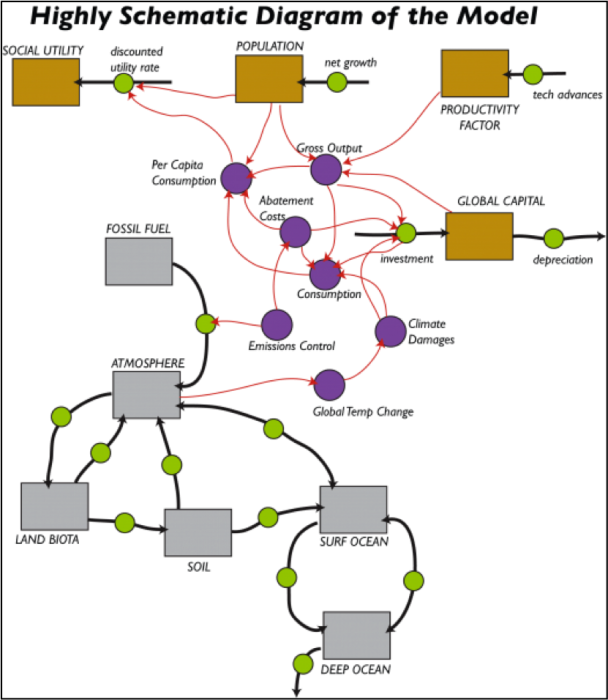Activity: Modeling the Economics of Climate Change
Video: Model Introduction(2:24)
For the module ten summative assessment, we're going to be working with this very large and complicated model, that consists of a number of different parts. You can see down in here this is the global carbon cycle and then that includes the percent or the concentration of CO2 in the atmosphere. That concentration of CO2 in the atmosphere then feeds into a climate model that tells us the temperature. And that temperature then goes into determining the sort of climate damages caused by a global temperature, global warming. Those climate damage costs then affect the amount of money that we have leftover to invest in the economy. So here's global capital - this is the whole kind of the heart of the economic model up in here. So climate damages come into play here. Another important cost that comes into play are the abatement costs. These are the costs related to reducing carbon emissions. And so there's something down here called the emissions control rate that we'll fiddle around with. It represents, essentially, different choices we make about how much we're going to try to limit carbon emissions. That limits how much goes in the atmosphere, it limits the temperature, and so on. But it costs money, so there's a certain abatement cost per gigaton of carbon that you are not emitting into the atmosphere. There are a whole bunch of other parts of this global climate and climate and economic model, including something that keeps track of what Nordhaus calls social utility. The global population here is sort of fixed and these are a bunch of things that just sort of sum up some of these economic components of the model. So this is the big model that's behind the scenes. When you look at the actual model, you'll be seeing something like this - an interface where you're just going to change a few basic things. And& for this summative assessment, we're really just going to change the emissions control rate here, which is a graphical function of time.
The global climate system and the global economic system are intertwined — warming will entail costs that will burden the economy, there are costs associated with reducing carbon emissions, and policy decisions about regulating emissions will affect the climate. These interconnections make for a complicated system — one that is difficult to predict and understand — thus the need for a model to help us make sense of how these interconnections might work out. In this activity, we’ll do some experiments with a model that will help us do a kind of informal cost-benefit analysis of emissions reductions and climate change.
The economic part of the model we will explore here is based on work by William Nordhaus of Yale University, who is considered by many to be the leading authority on the economics of climate change. His model is called DICE, for Dynamic, Integrated Climate, and Economics model. It consists of many different parts and to fully understand the model and all of the logic within it is well beyond the scope of this class, but with a bit of background we can carry out some experiments with this model to explore the consequences of different policy options regarding the reduction of carbon emissions.
Nordhaus’ economic model has been connected to the global carbon cycle model we used in Module 8, connected to a simple climate model like the one we used in Module 4.
The economic components are shown in a highly simplified version of a STELLA model below:

In this diagram, the gray boxes are reservoirs of carbon that represent in a very simple fashion the global carbon cycle model from Module 8; the black arrows with green circles in the middle are the flows between the reservoirs. The brown boxes are the reservoir components of the economic model, which include Global Capital, Productivity, Population, and something called Social Utility. The economic sector and the carbon sector are intertwined — the emission of fossil fuel carbon into the atmosphere is governed by the Emissions Control part of the economics model, and the global temperature change part of the carbon cycle model affects the economic sector via the Climate Damage costs. Let’s now have a look at the economic portions of the model. You should view this video about the DICE Economic Model first, and then study the text that follows.
